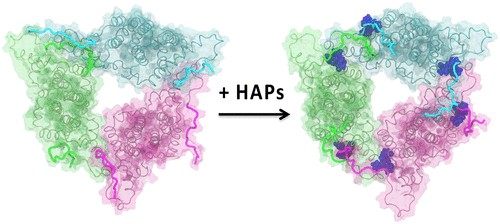当前位置:
X-MOL 学术
›
J. Chem. Inf. Model.
›
论文详情
Our official English website, www.x-mol.net, welcomes your feedback! (Note: you will need to create a separate account there.)
Identification of Factors Promoting HBV Capsid Self-Assembly by Assembly-Promoting Antivirals
Journal of Chemical Information and Modeling ( IF 5.6 ) Pub Date : 2018-01-24 00:00:00 , DOI: 10.1021/acs.jcim.7b00471 Soumya Lipsa Rath 1 , Huihui Liu 1 , Susumu Okazaki 1 , Wataru Shinoda 1
Journal of Chemical Information and Modeling ( IF 5.6 ) Pub Date : 2018-01-24 00:00:00 , DOI: 10.1021/acs.jcim.7b00471 Soumya Lipsa Rath 1 , Huihui Liu 1 , Susumu Okazaki 1 , Wataru Shinoda 1
Affiliation

|
Around 270 million individuals currently live with hepatitis B virus (HBV) infection. Heteroaryldihydropyrimidines (HAPs) are a family of antivirals that target the HBV capsid protein and induce aberrant self-assembly. The capsids formed resemble the native capsid structure but are unable to propagate the virus progeny because of a lack of RNA/DNA. Under normal conditions, self-assembly is initiated by the viral genome. The mode of action of HAPs, however, remains largely unknown. In this work, using molecular dynamics simulations, we attempted to understand the action of HAP by comparing the dynamics of capsid proteins with and without HAPs. We found that the inhibitor is more stable in higher oligomers. It retains its stability in the hexamer throughout 1 μs of simulation. Our results also show that the inhibitor might help in stabilizing the C-terminus, the HBc 149–183 arginine-rich domain of the capsid protein. The C-termini of dimers interact with each other, assisted by the HAP inhibitor. During capsid assembly, the termini are supposed to directly interact with the viral genome, thereby suggesting that the viral genome might work in a similar way to stabilize the capsid protein. Our results may help in understanding the underlying molecular mechanism of HBV capsid self-assembly, which should be crucial for exploring new drug targets and structure-based drug design.
中文翻译:

确定通过促进组装抗病毒药物促进HBV衣壳自我组装的因素
目前,大约有2.7亿人感染了乙型肝炎病毒(HBV)。杂芳基二氢嘧啶(HAP)是靶向HBV衣壳蛋白并诱导异常自组装的抗病毒药家族。形成的衣壳类似于天然衣壳结构,但是由于缺少RNA / DNA而不能繁殖病毒后代。在正常条件下,自组装是由病毒基因组启动的。但是,HAP的作用方式仍然未知。在这项工作中,我们使用分子动力学模拟,试图通过比较带有和不带有HAP的衣壳蛋白的动力学来了解HAP的作用。我们发现该抑制剂在较高的低聚物中更稳定。在整个1μs的仿真过程中,它在六聚体中均保持其稳定性。我们的结果还表明,该抑制剂可能有助于稳定衣壳蛋白C末端(富含HBc 149-183精氨酸的域)。在HAP抑制剂的协助下,二聚体的C末端相互相互作用。在衣壳装配过程中,末端应该与病毒基因组直接相互作用,从而表明病毒基因组可能以类似的方式稳定衣壳蛋白。我们的结果可能有助于理解HBV衣壳自组装的潜在分子机制,这对于探索新药物靶标和基于结构的药物设计至关重要。因此表明病毒基因组可能以相似的方式稳定衣壳蛋白。我们的结果可能有助于了解HBV衣壳自组装的潜在分子机制,这对于探索新药物靶标和基于结构的药物设计至关重要。因此表明病毒基因组可能以相似的方式稳定衣壳蛋白。我们的结果可能有助于了解HBV衣壳自组装的潜在分子机制,这对于探索新药物靶标和基于结构的药物设计至关重要。
更新日期:2018-01-24
中文翻译:

确定通过促进组装抗病毒药物促进HBV衣壳自我组装的因素
目前,大约有2.7亿人感染了乙型肝炎病毒(HBV)。杂芳基二氢嘧啶(HAP)是靶向HBV衣壳蛋白并诱导异常自组装的抗病毒药家族。形成的衣壳类似于天然衣壳结构,但是由于缺少RNA / DNA而不能繁殖病毒后代。在正常条件下,自组装是由病毒基因组启动的。但是,HAP的作用方式仍然未知。在这项工作中,我们使用分子动力学模拟,试图通过比较带有和不带有HAP的衣壳蛋白的动力学来了解HAP的作用。我们发现该抑制剂在较高的低聚物中更稳定。在整个1μs的仿真过程中,它在六聚体中均保持其稳定性。我们的结果还表明,该抑制剂可能有助于稳定衣壳蛋白C末端(富含HBc 149-183精氨酸的域)。在HAP抑制剂的协助下,二聚体的C末端相互相互作用。在衣壳装配过程中,末端应该与病毒基因组直接相互作用,从而表明病毒基因组可能以类似的方式稳定衣壳蛋白。我们的结果可能有助于理解HBV衣壳自组装的潜在分子机制,这对于探索新药物靶标和基于结构的药物设计至关重要。因此表明病毒基因组可能以相似的方式稳定衣壳蛋白。我们的结果可能有助于了解HBV衣壳自组装的潜在分子机制,这对于探索新药物靶标和基于结构的药物设计至关重要。因此表明病毒基因组可能以相似的方式稳定衣壳蛋白。我们的结果可能有助于了解HBV衣壳自组装的潜在分子机制,这对于探索新药物靶标和基于结构的药物设计至关重要。


























 京公网安备 11010802027423号
京公网安备 11010802027423号